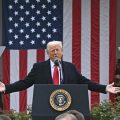
Donald Trump’s trade policies, particularly his aggressive use of tariffs, represent more than just a departure from traditional economic thinking; they’re a misguided attempt to rewind the clock to a bygone era of American manufacturing dominance. This nostalgic approach, however, ignores the complexities of the global economy and ultimately proves self-defeating. The belief that imposing tariffs will magically restore lost jobs and revitalize domestic industries is a dangerous fantasy, disconnected from the realities of international trade and supply chains.
The core problem lies in the fundamental misunderstanding of how global trade functions. While tariffs might temporarily protect certain industries from foreign competition, they also inflict significant harm on other sectors of the economy. Consumers face higher prices for imported goods, businesses reliant on imported components see their costs increase, and the retaliatory tariffs imposed by other nations further damage American exports. This creates a domino effect, impacting jobs and economic growth in unexpected and often detrimental ways. It’s a zero-sum game where the perceived gains in one area are vastly outweighed by losses elsewhere.
Furthermore, the idea that the US can simply isolate itself from the global market is unrealistic in the 21st century. The intricate web of international trade and interconnected supply chains makes such a strategy untenable. Attempting to force a return to a simpler, more isolated economic model is like trying to fit a square peg into a round hole. The result is friction, inefficiency, and ultimately, economic stagnation.
The long-term consequences of Trump’s tariff strategy are likely to be far-reaching and negative. While short-term political gains might be achieved by appealing to protectionist sentiments, the economic costs will far outweigh any perceived benefits. The damage to international relationships, the disruption of global supply chains, and the overall negative impact on economic growth will leave lasting scars on the American economy. Ultimately, Trump’s tariffs serve as a cautionary tale: a misguided attempt to manipulate the past, resulting in a bleak future.
The solution lies not in protectionism but in embracing the opportunities presented by a globalized economy. Investing in education, infrastructure, and innovation, while fostering international cooperation, are far more effective strategies for ensuring long-term economic prosperity and creating a truly competitive American workforce. Rather than trying to turn back the clock, we should be focusing on building a brighter future through strategic investment and collaboration, not isolation and trade wars.










